The Splendid Glories of the Full Moon
Of all the hundreds of thousands of luminous bodies that we might see in our night sky, none are quite as enchanting, splendorous and glorious as a full Moon. The full Moon has inspired the adoration of mankind for millennia and become the focus of countless works of science, art and poetry.
The sages of ancient India tell us that an autumnal full Moon even inspired Lord Kṛṣṇa himself. The chapters of Śrimad Bhāgavata Purāṇa which describe this episode open with a beautiful description of that mesmerizing full Moon:
दोडुराजः ककुभः करैर्मुखं प्राच्या विलिम्पन्नरुणेन शन्तमैः |
स चर्षणीनामुदगाच्छुचो मृजन्प्रियः प्रियाया इव दीर्घदर्शनः ||
“At that time the Moon rose, tinting the face of the eastern horizon with his soothing reddish rays and clearing away the distress of all who watched, just like a lover seen after a long time by his beloved.”
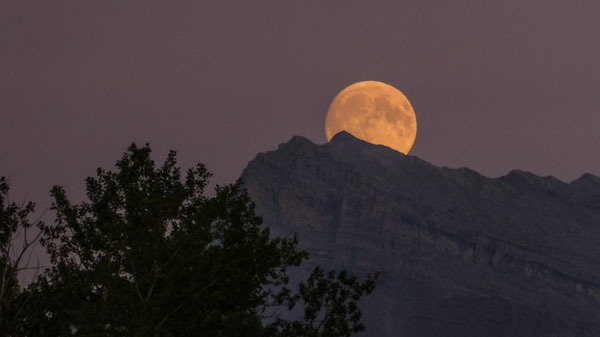
दृष्ट्वा कुमुद्वन्तमखण्डमण्डलं रमाननाभं नवकुङ्कुमारुणम् |
वनं च तत्कोमलगोभी रञ्जितं जगौ कलं वामदृशां मनोहरम् ||
“Seeing the unbroken disc of the crimson full Moon, resembling the fresh kuṃkuṃ-dusted face of Ramā herself, and the forest of Vṛndāvana with freshly blooming kumuda night lotuses lit by the gentle rays of that Moon, the Lord played His flute sweetly, captivating the minds of the beautiful-eyed [gopīs].”
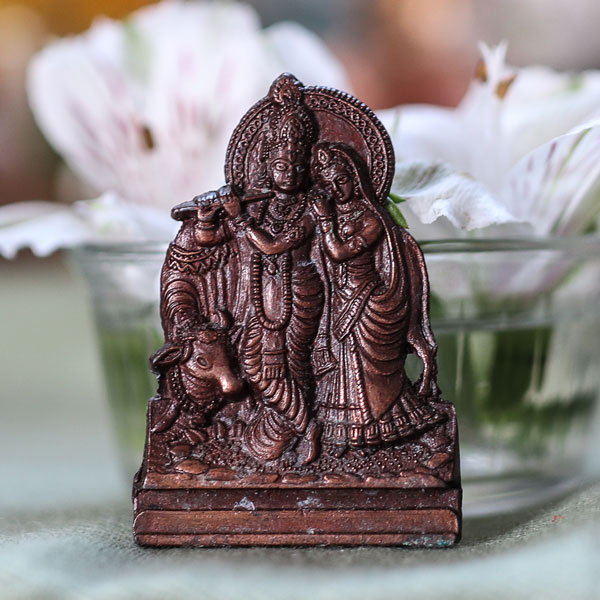
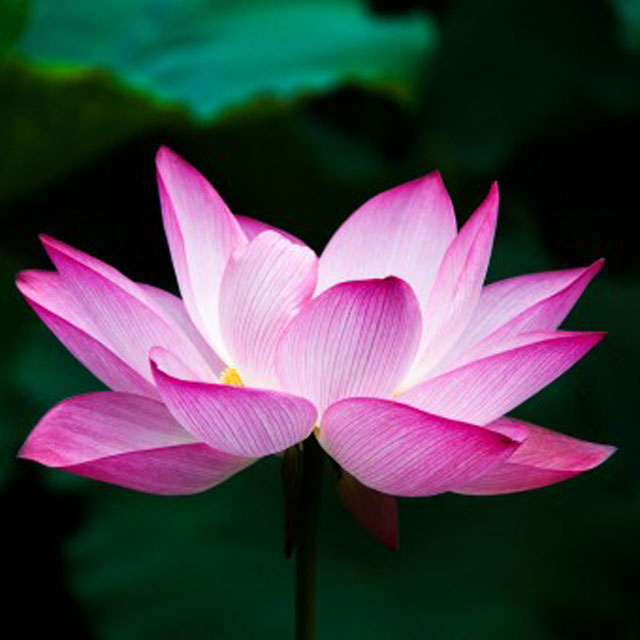
Honoring the Full Moon
This special full Moon night of the autumn season continues to be celebrated and honored by Hindus to this day, on the festival of Śarad Purṇimā. Another very famous full Moon celebration is the wonderful spring festival of Holī, often known as the “festival of colors”. And by no means is this the end of the full Moon celebrations within the Indian spiritual traditions: other such celebrations include Hanumān Jayantī, birth of the much-loved Hanumānji; Buddhists celebrate Buddha’s Birthday on Buddha Purṇimā – sometimes known as Vesāk or Buddha Jayantī; Sikhs celebrate Guru Nānak’s birth on the full Moon festival of Gurpurab. And then of course, there is one of the most well-known full Moon celebrations: Guru Purṇimā, falling on the Purṇimā tithī of Āṣāḍha month.
Guru Purṇimā is also known as Vyāsa Purṇimā and is traditionally said to mark the birth of the illustrious Mahaṛṣī Vyāsa, son of Mahaṛṣī Parāśara who needs no introduction amongst students of Jyotiṣa. The importance of Mahaṛṣī Vyāsa to the Vedic tradition cannot be overstated: it is Vyāsa who is credited with compiling the Vedas in the form we receive today, and for composing one of the great epics of India, the Mahābhārata. The well-known Bhagavad Gītā is excerpted from this Mahābhārata.
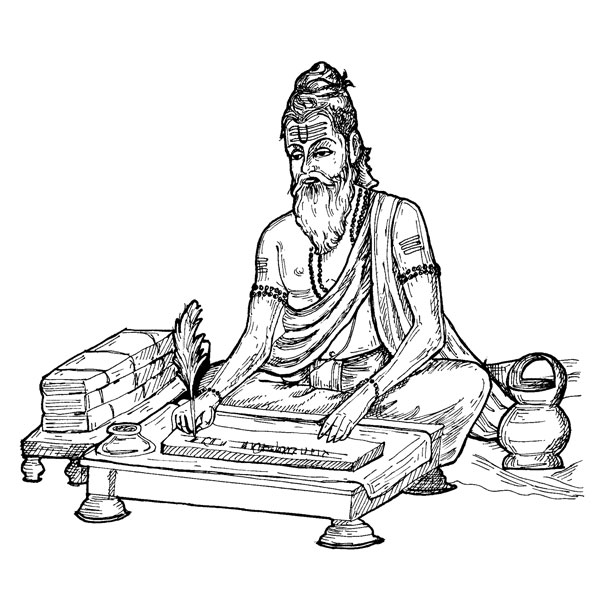
For these reasons, on Guru Purṇimā day Hindus of all different sects and traditions honor Mahaṛṣī Vyāsa and express gratitude for his work in preserving and perpetuating the Vedic tradition. And of course, every teacher/Guru prior and subsequent to Vyāsa has played their own necessary and significant role in the preservation of the tradition, and so every teacher within the tradition is honoured on this day, including one’s own.
Finally, it should be noted that the traditional full Moon celebrations are not just on a collective level. For an individual, the Vedic tradition gives special significance to a person’s 80th birthday, with elaborate celebrations and rituals recommended. This 80th birthday celebration is called Śatābhiṣekam, or Sahasra Candra Darśana. Its significance derives precisely from the fact that an individual of this age has lived to see a thousand full Moons!Considering all this, it is clear that for the sages of the Vedic tradition, the full Moon was a very significant phenomenon indeed. There was a notable emphasis on actually seeing the full Moon. For our illustrious forebears, Jyotiṣa was not just about the technicalities of some scribbles on a piece of paper; it was a living experience, centered on understanding the mood of the how the heavens were dressed up. Amongst the many jewels that can adorn the heavens, few can compete with the beauty of a gorgeous full Moon.
The Significance of a Full Moon in Natal Astrology
In Phaladīpikā, an important classical text on Jyotiṣa, the sage Mantreśvara instructs us to speak on the results of the Moon’s daśā only after considering the Moon’s strength, and then proceeds to tells us that in the middle ten days of a lunar month (i.e. five days either side of Purṇimā tithī) the Moon is in full strength. When it comes to the Moon in a birth chart, the first consideration should be how bright the Moon is. A full or fullish Moon is a strong and auspicious feature in a horoscope. The fullness of the Moon in a natal chart can be assessed by considering its position relative to the Sun. When the Moon is exactly opposite the Sun (i.e. 180º away) it enjoys maximum fullness. A useful rule of thumb in practical work is that if the Moon falls in the 6th, 7th or 8th bhāva from the Sun, it may be considered to be a full or fullish MO and therefore strong and benefic.
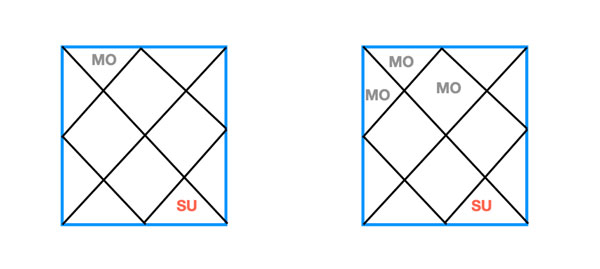
The next natural question is what sorts of effects might we expect in the life of somebody born under a full Moon? This is where things get trickier, as conclusions in Jyotiṣa can never be reached on the basis of just one factor. It is essential that the horoscope be examined holistically, with a view to understanding the context in which the full Moon exists.
In his chapter describing the results of the Viṃśottarī Mahādaśā, Mahaṛṣī Parāśara tells us that the daśā of a strong Moon will give:
कर्मभाग्याधिपैर्युक्ते वाहनेशबलैर्युते ।
आद्यन्तैश्वर्यसौभाग्यधनधान्यादिलाभकृत ॥
गृहे तु शुभकार्याणि वाहनं राजदर्शनम् ।
यत्नकार्यार्थसिद्धिः स्याद् गृहे लक्ष्मीकटाक्षकृत् ॥
मित्रप्रभुवशाद्भाग्यं राज्यलाभं महत्सुखम् ।
अश्वान्दोल्यादिलाभं च श्वेतवस्त्रादिकं लभेत् ||
पुत्रलाभादिसन्तोषं गृहगोधनसंकुलम् ।
धनस्थानगते चन्द्रे तुङ्गे स्वक्षेत्रगेऽपि वा ॥ २१॥
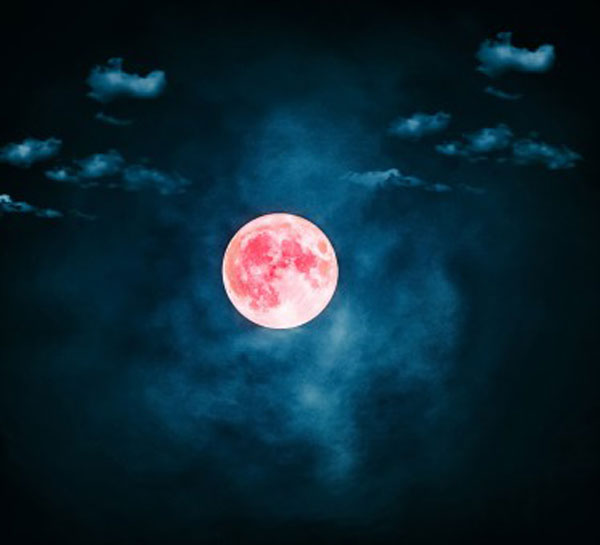
…“from beginning to end opulence and lordship, good fortune, gain of wealth, food etc. auspicious celebrations at home, vehicles, association with the king, success in one’s endeavours and works, blessings of the Goddess Lakṣmī at home, good fortune through powerful friends, gain through royalty, great happiness and comfort, gain of horses, carriages and white clothing etc., happiness from gaining sons etc. and an abundance of cattle-wealth at home”….
Whilst these statements cannot be applied literally in our current context, they do emphatically steer us in the direction of the kinds of results that we can hope for from a strong Moon. Assuming that the wider ecosystem of the chart is supportive, we might expect a strong and full Moon to bless a person with a strong and charismatic presence, an attractive and radiant personality, physical beauty, a refined sense of aesthetics, artistic interests, a caring and nurturing streak to their character, a gracious demeanor, opulence and wealth and a close bond with the mother, amongst other things.
Jyotiṣa is always best learnt through analysis of real horoscopes so let us look at some charts with a focus on their full Moons.
Judy Collins, American Singer and Activist 5

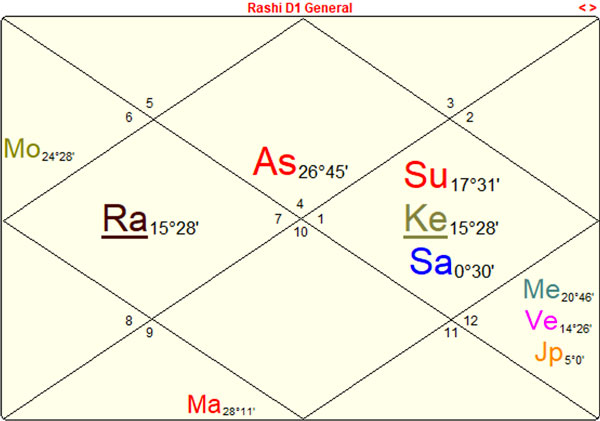
Judy Collins has a beautifully placed full Moon which is central to this horoscope as it is also the lagna lord. Not only is the Moon strong by virtue of its fullness, it is tremendously stabilized by aspects from a strong Jupiter, Venus and a benefic Mercury; additionally, this Moon is free from all malefic destabilization.
As if this weren’t enough, this full Moon sits in a chart brimming with auspicious yogas that promise many blessings and much success in life. There is the powerful Sarasvatī yoga formed by the benefics in the 9th bhāva, along with a gorgeous Lakṣmī yoga. Numerous lordship-based Rāja yogas are formed (9/10, 4/9, 1/9, 1/4) along with Dhana yogas (1/11, 9/11, 1/9).
With all this beautiful activity going on across the 3/9 axis and involving the lords of these bhāvas, Collins was a very successful singer and songwriter who enjoyed a career spanning over 60 years. She is very skilled in her craft and enjoys a radiant, charismatic and beautiful appearance. She also became prominent through the social activism that she was involved in for a significant portion of her life. It goes without saying that she has also enjoyed much wealth, privilege and opulence in her life.
Prince George of Cambridge 6

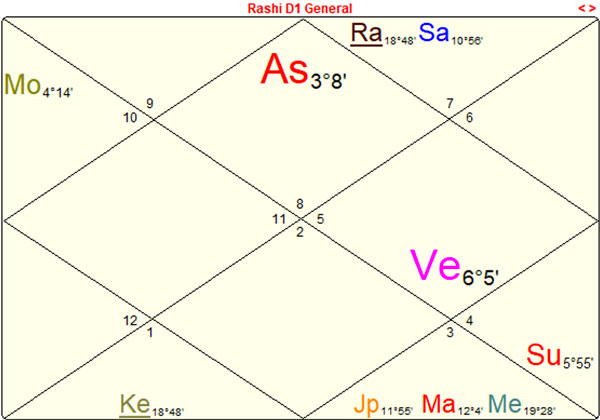
At first glance, the chart of young Prince George may look deceptively uninspiring but a deeper inspection again reveals quite a context for the Prince’s full Moon: most significant is the fact that the mutual aspect between the Sun and Moon here creates not only a completely full Moon, but also a potent Raja Yoga between these grahas as lords of the 9th and 10th bhāvas. Sage Parāśara specifically tells us that the Sun and Moon become yoga kārakas for a chart with a Scorpio lagna, and links between the 9th and 10th bhāvas/lords are commonly observed in the charts of those involved with politics, government and royalty.
In addition to these yogas, the presence of all the natural benefics in the 6th and 8th bhāvas from the Moon creates a Candrādhi yoga-like pattern, supporting both sides of the Moon by aspect, and also a powerful Śubha Ubhayacarī yoga around the Sun; both of these are combinations for pre-eminence and success. On top of all this, we have a completely unafflicted Venus sitting in the 10th bhāva creating an Amala Yoga. Furthermore this Venus is placed right on the fixed star Regulus, the yoga tāra of Magha nakṣatra. As its very name implies, this star is directly associated with royalty in both Jyotiṣa and the classical Western astrological tradition. There are also multiple Dhana and Rāja yogas formed through lordship in the 8th bhāva (legacies and inheritance) of this chart.
Prince George was born into his Sun daśā, to be followed by his Moon daśā, thereby activating his powerful Raja yoga right from birth. It would be readily apparent to a competent astrologer that the owner of this horoscope was likely born in an affluent, noble and eminent family.
Although Prince George is still a child, he is the eldest child of the Duke and Duchess of Cambridge, Prince William and Kate Middleton, and is therefore directly in line to sit on the throne of the British royal family, arguably the most well-known monarchy in the world. His chart reflects this very unique destiny, and we can expect that in time, the Prince’s full Moon will bless him with strong charisma and presence, grace, opulence and wealth.
The Full Moon as Giver of Rāja Yoga
Under the right circumstances, the Full Moon is capable of creating powerful Rāja yogas. The Rāja yogas of Jyotiṣa are auspicious and desirable configurations that bless an individual with success, elevation, promotion and upward social mobility. Most students of Jyotiṣa are aware of the Dharma-Karma-Adhipati yogas, a subset of Rāja yogas that form when the lords of kendras and trikoṇas are in mutual saṃbandha (an example of this is the Raja yoga we saw in Prince George’s chart, formed by the Moon and Sun as lords of the 9th and 10th respectively). However, these are not the only way in which Rāja yogas are formed, and the classical literature of Jyotiṣa provides details of many other ways in which powerful Rāja yogas can be formed.
One key source for such information is chapter seven of Phaladīpikā. Here, Mantreśvara provides details of a number of rare and powerful Rāja yogas that are very worthy of study. A good number of these yogas feature the full Moon as the star of the show. Here is a summary of these Rāja yoga formations:
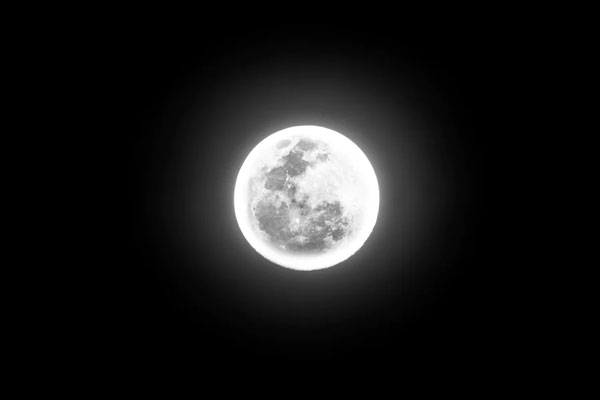
- A full Moon aspected by a graha in its own or exaltation rāśi. This is especially powerful if the Moon occupies a kendra (other than the lagna);8
- A full Moon occupying Leo navāṃśa, whilst there are unafflicted benefics in kendras;9
- A full, uneclipsed Moon in the 9th bhāva, aspected or associated by friendly planets;10
- A full, vargottama Moon;11
- A full Moon in Pisces, aspected by a friend;12
- A full, exalted Moon.13
As with all factors in Jyotiṣa, these yogas cannot be taken in isolation. The overall context of the horoscope in which they sit must be taken into consideration. Providing that there is a supportive context, these yogas will then lift a horoscope to higher level, expanding the size of the canvas on which the life will play out.
If we now refer back to the chart of Judy Collins in light of these yogas, we see that her full Moon is aspected by Jupiter in its own rāśi and also by an exalted Venus. The full Moon in her chart thus created additional Rāja yogas that might not have been spotted at first glance.
Alexandria Ocasio-Cortez, American Congresswoman 14

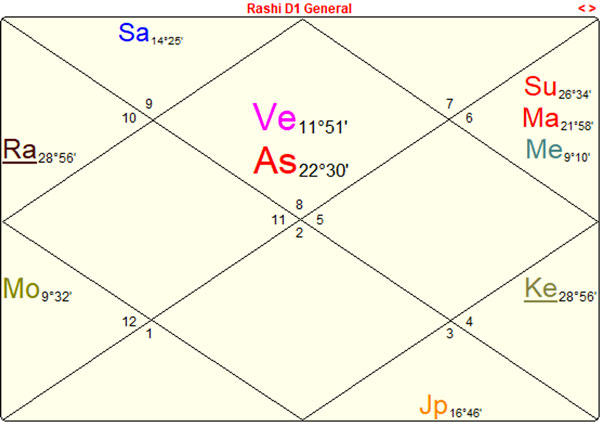
One more example of these yogas at work is in the chart of Alexandria Ocasio-Cortez, commonly known by her initials as “AOC”. AOC is a prominent contemporary figure in US politics, currently serving as a Member of the U.S. House of Representatives from New York's 14th district.
In contrast with Judy Collins’ unafflicted and completely stabilized full Moon, AOC’s full Moon suffers some serious affliction from the natural malefics Mars and Mercury (who becomes malefic here due to the association with malefics Mars, Sun and an aspect from malefic Saturn). These grahas are also lords of the 6th and 8th bhāvas respectively, adding to their virulence. We can therefore expect the results to be edgier and more challenging in some respects.
Nonetheless this full Moon also sits within a chart that provides some supportive context. The presence of an unafflicted Venus in the lagna gives a notable Śubha yoga, and the mutual aspect of the Sun and Moon gives the same 9/10 Rāja yoga we saw in the chart of Prince George. Now examine this full Moon in light of the Phaladīpikā Rāja yogas listed above. Observe that we have a full Moon aspected by an exalted graha, and a full Moon in Pisces aspected by friendly grahas; this Moon is highly Rāja yogic and significantly boosts up the magnitude of this chart.
AOC is a highly intelligent, eloquent and charismatic lady and is the youngest woman to have ever served in the United States Congress, taking office at age 29 in her Ketu-Moon daśā-bhukti. The Moon very obviously gives the result of the Raja yogas we have discussed, but it should be noted that Ketu gives exclusively the results of the Moon and Mercury in this chart (being in the Moon’s rāśi and in a nakṣatra of Mercury). These are the very two grahas who form one of the full Moon Rāja yogas in this chart and so this period was destined to yield the results of the powerful Rāja yogas formed in this horoscope.
AOC is popular, in touch with the common people and is unafraid to argue for her principles, often campaigning indefatigably to bring about what she perceives to be necessary change. With her Moon being so afflicted her success has never come easily: born into a working class immigrant family, her father died while she was still a teenager (note that the afflicted Moon is her 9th lord; the 9th bhāva is also afflicted by the RA/KE axis, with no benefic influence on the bhāva or bhāva lord) leaving the family in financial difficulty and forcing her to work as a waitress and bartender whilst also pursuing her studies; more recently, as a politician she has repeatedly had to face controversy, argumentation and personal insults directed towards her.
Nonetheless, her lagna lord Mars with Mercury aspecting her 2nd bhāva gives her sharp and incisive speech, making her more than capable of defending herself against her detractors. With 2nd lord Jupiter aspecting her 2nd bhāva, she has the capacity for intelligent and graceful speech, but with malefic Mars and Saturn also influencing the bhāva, there are strong tendencies for her speech to be blunt, coarse, acerbic, impulsive and controversial. She would be well-counseled to be aware of these tendencies and to actively cultivate the ability for graceful and intelligent speech that Jupiter indicates.
In Conclusion
This article has highlighted the significance of the Full Moon not just in an astrological context, but also within the context of the wider Vedic spiritual tradition as it has been handed down to us today. As aspiring students of Jyotiṣa, we seek to embed ourselves within the worldview of the sages who developed Jyotiṣa and to shape our channels of thinking accordingly.
Key to this is the awareness that Jyotiṣa likely began when our illustrious forebears looked up and noticed the heavenly phenomena shining above, remaining open to the inspiration this produced. For our studies to be fruitful today, we must remember that the charts we analyze on paper are a sketch of a real sky pattern. Consider what that pattern would have looked like and what ideas this might inspire. The full Moon is one piece of the pattern that we can easily spot in a chart. We can readily visualize and imagine it in the sky. Retrograde grahas will also standout in the night sky as particularly bright objects calling for the attention of anyone who cares to look. With such a full appreciation of the sky pattern represented by the horoscope, we can proceed to illumine the patterns of karma-phala lying hidden in the horoscope waiting to be unravelled by one who sees the light. For without seeing and appreciating the jyoti15, there can be no true Jyotiṣa
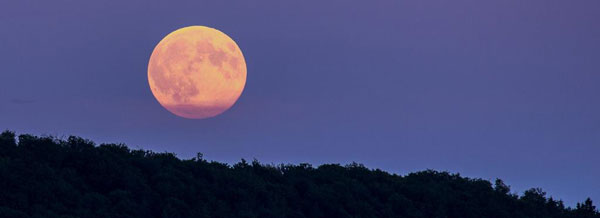
Author: Pursottam Dabasia

Pursottam holds a degree in Cognitive Science and currently works as a data analyst. Of Indian heritage but born and raised in the UK, he has a deep interest in the traditions of classical India and enjoys studying subjects such as Sanskrit, Vedanta and Indian Classical Music. He has been a student of Jyotisha since 1997.
- Pic 1 https://images.unsplash.com/photo-1532672542812-56df0f657abe?ixlib=rb-1.2.1&ixid=eyJhcHBfaWQiOjEyMDd9&auto=format&fit=crop&w=900&q=60
- Pic 3 https://c.pxhere.com/photos/ee/42/lotus_flower_summer_zen_lake_nature_pink_china-686830.jpg!s
- Pic 4 https://clipground.com/images/marharshi-clipart-3.jpg
- Pic 5 https://c.pxhere.com/images/32/44/46714ad77c730663d37bd46ac7c2-1444665.jpg!s
- Pic 8 https://images.unsplash.com/photo-1579021289055-fc2679991a35?ixlib=rb-1.2.1&ixid=eyJhcHBfaWQiOjEyMDd9&auto=format&fit=crop&w=900&q=60
- Pic 9 https://commons.wikimedia.org/wiki/File:Alexandria_Ocasio-Cortez,_official_portrait,_116th_Congress.jpg
- Pic 10 https://free-images.com/md/19ea/full_moon_super_moon_0.jpg
End Notes
- Śrimad Bhāgavata Purāṇa 10:29:2-3
- Phaladīpikā 19:8
- The daśā systems are Jyotiṣa’s primary tool for determining the time periods when the potentials shown in a natal chart will manifest in a lifetime. Whilst there are dozens of different daśā systems, the Viṃśottarī daśā system is perhaps the most important. In this system, each of the nine planets rules over certain time periods in an individual’s life. The results indicated by a given planet in the natal horoscope can be expected during the time period ruled by the planet i.e. that planet’s mahādaśā.
- Bṛhat Pārāśara Horā Śāstram 49:18-21
- Birth data: 01 May 1939; 11:55; Seattle, Washington (USA)
- Official birth data: 22 July 2013; 16:24; London (England). Birth time provisionally rectified to 16:23 by the author
- Bṛhat Pārāśara Horā Śāstram 36:35
- Phaladīpikā 7:7
- Phaladīpikā 7:11
- Phaladīpikā 7:14. The definition of ‘friendly planets’ is open to interpretation here. A truly full Moon will necessarily be aspected by the Sun. Are we then to count this as a friendly aspect? If not, then the only option left is an aspect from Mercury. If we use Parāśara’s more complex scheme which considers both natural and temporal relationships, then neither Sun nor Mercury will ever qualify, as their placement when associating with or aspecting the Moon will render them as neutrals. One more consideration is that the Sanskrit word used for “by friends” is plural, implying three or more candidates! One final approach would be to use broader groupings of friendly planets, which would include the Sun, Moon, Mars and Jupiter as one group.
- Phaladīpikā 7:17
- Phaladīpikā 7:22
- Phaladīpikā 7:22
- 14 Birth data: 13 October 1989; 11:50; Bronx, New York (USA)
- “Light”.






